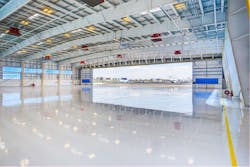For an architect fortunate enough to be involved in the aviation industry, there is almost an unparalleled opportunity for design inspiration. Over the past century of flight, architects have used this inspiration to develop incredible commercial aviation facilities throughout the country, yet it has only been during the past couple of decades that this same inspiration has migrated into the general and corporate aviation community. For many in this community, the simple metal “wrinkle-tin” building that has been so prevalent over the past 50 years is quickly being replaced by more modern facilities that are exceeding the design and amenities of their commercial carrier counterparts. This transformation can be challenging, time consuming and costly if the specific needs of the operator, tenants, and regional conditions are not carefully considered.
Over the past two decades I worked with this challenge to generate unique results for each project, yet I’ve done so with a determined and consistent approach for each. Recent projects with Atlantic Aviation have allowed me and my colleagues at JRMA Architects and Engineers, to truly evaluate how to work with a national-based FBO chain to maintain their standards, while adapting to various locales. The primary intent for these projects was to first deliver a successful solution for the client, yet it was also the development of a replicable design and build approach that could be used to enhance the next project and allow for further focus on what drives each project’s success.
The projects designed for Atlantic Aviation occurred over an approximate 5-year period, many being designed concurrently, and included a new FBO and Hangar Facility at Houston Hobby Airport (HOU) and Portland International Airport (PDX), a Hangar expansion to the existing FBO at Los Angeles International Airport (LAX), a complete renovation of an existing FBO at George Bush International Airport (IAH) and a new FBO and Hangar Facility currently under construction at Salt Lake City International Airport (SLC). Each of these projects developed their own “story” and provided JRMA with a better understanding of Atlantic’s operations. A consistent theme started to develop for all that centered around Defining Expectations and Drivers, Establishing Appropriate Performance Criteria, and Execution and Management of the Process. Oddly enough, for an architect, there became a realization during this process that “design” was not the only answer to a successful project, rather it was more an element to tie into the process.
Although possibly obvious, the very first question for defining the expectations for a new facility is “why do you need it, and when do you need it?” The “why” for Atlantic HOU, PDX, LAX and SLC were all nearly the same: the need for hangar space was greater than the current capacity and these improvements also would assist in securing longer leases. Beyond the need for more space, some projects demand more, and for Atlantic HOU the requirement was to deliver an “iconic” design per the Houston Airport System (HAS) to complement the commercial terminal improvements. As one of the busiest bases in the country for Atlantic, their primary goal was to avoid impacting their ongoing operations while dramatically improving the efficiency of a facility that had its origins 60 years ago as a maintenance operation for Eastern Airlines. Knowing these two drivers led to a flight-inspired butterfly roof FBO along the main airport access drive to respond to the HAS’s requirement for a progressive design. Atlantic’s enhancement of their operation was answered with and a widened 450’ ramp flanked by two new 37,000 SF hangars and a renovated 45,000 SF hangar, all with the focal point of the FBO at the head of the ramp area. Nearly as important as the facility layout was the “when” of the project. This was dictated by multiple complex phases of moving tenants from hangar to hangar as each was completed to ensure that ongoing operations were not impacted. All this effort was orchestrated with the overall completion and operation of the FBO just a week before Super Bowl LI in Houston.
Perhaps another obvious upfront expectation is cost, although this can be complicated to fully address at the early stages of a project. The program, phasing, timeline and finish level of the project all need to be established as soon as possible in order to set the right track for the cost model. For expedited projects, such as with Atlantic PDX, one solution came down to a Design-Build delivery method in which the owner, contractor and architect are all on-board from day-one of the project. JRMA teamed with Portland-based Centrex Construction to design and deliver two new hangars, a new FBO and a renovated ground service equipment building. The entire process for the $25 million project, from design conceptions to project completion was accomplished within an amazingly short duration of 20-months, which included wrapping up the project in one of Portland’s worst winters in decades. Although a fast-track project can have the potential for cost overruns, the costs for Atlantic PDX were kept in check through the realistic development of a concept design, cost model, and appropriate contingencies for “what-ifs” early on in the project. A concerted effort was made by all team members to hold as close to the initial concept and costs as possible, and when the “what-ifs” occurred, to evaluate these against schedule and budget impacts. The key take-away from this process was to continually look forward far enough into the project to accurately gauge the current work effort and take advantage of opportunities for improving the design, schedule or budget.
Once a decision has been made on the budget, then starts the much more challenging “bargaining” of where to allocate it within the project. This decision should be made by looking at the fundamental objectives and expectations for the project. For Atlantic HOU, minimal impacts to their current on-site operations was paramount, thus a more expensive and longer duration phased project was required. For Atlantic PDX, the new facility was completely detached from the current operations, thus the contractor had the ability to construct all phases concurrently. This allowed the primary focus for PDX to be a balance of operational efficiency for the facility and creating a “northwest modern” lodge style FBO that fit in the context of Portland area. Within the FBO, there was careful consideration of “public” area higher-end finishes as opposed to the more durable “back-of-house” finishes at Line Service, Support and Administrative Offices. The variance between these levels of finishes can be nearly two or threefold, thus knowing what is impactful to your customers and what they expect should be closely evaluated. The solution for Atlantic PDX, given its regional context, was to place the Lobby and higher-end finishes under a soaring wood roof anchored by two massive stone fireplaces. The roof defined the land-side and air-side entries and provide direct visual access through the entire FBO. The more basic finish levels for back-of-house operations were used at the support areas flanking either side of the lobby. Similar interior and exterior finishes to the FBO were then used at the hangars and tenant offices to carry through the northwest theme to the entire campus without having to allocate the same cost as the customer focused areas.
Whereas Atlantic PDX and Atlantic HOU had a primary goal of establishing a unique customer experience at the FBO, many aviation facilities, such as the new hangar for Atlantic at LAX had a stronger basis in operations and the need to adhere to unique performance criteria. The program for the project was to create a 43,000 SF maintenance hangar on an under-utilized area of the existing site that could accommodate up to four Gulfstream G650 aircraft. Knowing the exact make-up of the aircraft and the level of operations within the hangar allowed for the proper distribution of aircraft power, house power, compressed air, water, aircraft grounds and lavatory dump stations. To optimize the aircraft power distribution and load, the number of simultaneously connected aircraft, or diversity, was evaluated to result in a more efficient and less costly electrical distribution system. The same process was followed for the interior lighting by supplementing the LED lighting with prismatic lens skylights and polycarbonate wall panels that distribute natural light throughout the hangar. This combination ensured the floor level illumination that Atlantic required for maintenance and operations. The temperate Southern California climate also allowed for simple ventilation with the hangar via large-rotor fans with make-up air through wall mounted louvers. The exterior of the hangar, in keeping with the clean operations-oriented interior, took on a very modern character with metallic colored architectural metal wall panels and blue-tinted glazing. The efficient layout and design of the systems within the hangar in combination of an energy efficient exterior envelope also had the added benefit of creating a sustainable hangar that yields energy costs savings to Atlantic for the life of the building while also adhering to the local Green Design Building Codes.
The upfront effort of establishing a project’s expectations can certainly assist in setting a pathway to a successful aviation facility, although without managing the process correctly, the odds of achieving complete success are somewhat diminished. The experience with the Atlantic projects all had the key element of owner engagement throughout, including the full-time participation of a Construction Director. This set-up allowed for direct communication and timely responses on behalf of the owner and their tenants. It also streamlined the coordination with local airport and building agencies to work with the appropriate stakeholders and meet project schedules. This same format was followed during the construction process to ensure rapid response of information to keep each project moving. Most important, the active participation in the process by Atlantic allowed for careful analysis of the project delivery approach for each project and the best methodology for construction. As each project for Atlantic came to completion, the knowledge and experienced carried through to the next. This would only have been achievable through the continuity of the team members and proper documentation of their efforts.
The key learning JRMA took from the experience with Atlantic was to take time to focus the day-to-day efforts on the long-term success of a project. There were many instances where the team found themselves discussing what appeared to be insignificant items only to realize that an improper solution could lead to a very difficult, if not impossible, resolution later. This becomes more critical to understand given a 50-year plus service life of a building. A simple apparent savings today can easily cost an owner significantly over the building life, likewise spending the effort during the design and construction can yield similarly substantial benefits down the road. It is important to allow for the opportunity to clearly define expectations, establish a budget, know where to spend the budget and to properly manage the entire process. A consistent approach on this is one that allowed JRMA to provide success for Atlantic, and a process I hope can used by others as they encounter similar endeavors.
Dan Bianco is a licensed architect and President of JRMA Architects and Engineers based in Orange County, California. Dan brings nearly thirty years of experience to the firm with a focus on designing aesthetically innovative and operationally efficient aviation facilities. Dan has led the effort to develop solutions throughout the United States and abroad for over fifty aviation facilities including FBOs, MROs, Hangars, CBP/Customs, Air freight and Support Facilities.






